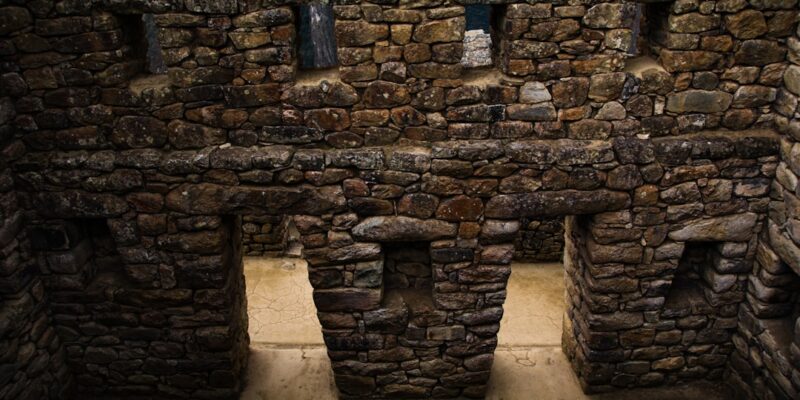
Discovering Machu Picchu: Hiking the Inca Trail
Machu Picchu and the Inca Trail are two of the most iconic and breathtaking destinations in the world. Located in the Andes Mountains of Peru, Machu Picchu is an ancient Inca citadel that was built in the 15th century and later abandoned. The Inca Trail is a famous hiking route that leads visitors to Machu Picchu, offering stunning views of the surrounding mountains and valleys along the way. Planning and preparation are crucial for a successful and enjoyable hike to Machu Picchu, as it is a physically demanding journey that requires careful consideration.
Key Takeaways
- Machu Picchu is a 15th-century Inca citadel located in the Andes Mountains of Peru.
- Planning ahead is crucial for a successful hike to Machu Picchu, including obtaining permits and acclimatizing to the altitude.
- The best time to hike the Inca Trail is during the dry season from May to September.
- Packing essentials for the hike include proper hiking gear, sunscreen, insect repellent, and a reusable water bottle.
- Hiking the Inca Trail is physically demanding and requires a good level of fitness and endurance.
The History of Machu Picchu and the Inca Trail
The Inca civilization was one of the most advanced and sophisticated ancient civilizations in the world. Originating in the 13th century, the Incas built an extensive empire that stretched across modern-day Peru, Ecuador, Bolivia, and parts of Chile and Argentina. Machu Picchu was constructed during the height of the Inca Empire as a royal estate for Emperor Pachacuti. It served as a religious, political, and administrative center for the Incas.
The Inca Trail played a significant role in Inca culture as it was used as a pilgrimage route to reach Machu Picchu. It was also an important trade route that connected various regions of the empire. The trail is made up of stone steps, terraces, and tunnels that were built by the Incas over 500 years ago. Today, hiking the Inca Trail is not only a physical challenge but also an opportunity to connect with the history and culture of the Incas.
Planning Your Hike: What to Know Before You Go
Before embarking on your Machu Picchu adventure, there are several important factors to consider. First and foremost, you will need to obtain permits to hike the Inca Trail. The Peruvian government strictly regulates access to the trail in order to preserve its natural and cultural heritage. It is recommended to book your permits several months in advance, as they are limited and can sell out quickly.
Choosing a reputable tour operator is also crucial for a successful hike. There are many tour companies that offer guided hikes to Machu Picchu, but not all of them provide the same level of service and expertise. It is important to do thorough research and read reviews before making a decision. Look for a company that has experienced guides, good safety records, and positive customer feedback.
Physical fitness is another important consideration when planning your hike. The Inca Trail is a challenging trek that involves steep ascents and descents, high altitudes, and long distances. It is recommended to engage in regular physical exercise and training prior to your trip to ensure that you are adequately prepared for the physical demands of the hike.
The Best Time of Year to Hike the Inca Trail
| Month | Average Temperature (°C) | Rainfall (mm) | Crowds |
|---|---|---|---|
| January | 12 | 150 | High |
| February | 12 | 140 | High |
| March | 12 | 100 | High |
| April | 11 | 50 | High |
| May | 9 | 20 | High |
| June | 7 | 10 | High |
| July | 7 | 10 | High |
| August | 8 | 10 | High |
| September | 10 | 20 | High |
| October | 11 | 50 | High |
| November | 12 | 100 | High |
| December | 12 | 150 | High |
The weather in the Andes can be unpredictable, so choosing the right time of year to hike the Inca Trail is essential. The dry season, which runs from May to September, is generally considered the best time to visit Machu Picchu. During this time, there is less rainfall and clearer skies, making for better hiking conditions and stunning views of the surrounding mountains.
However, the dry season is also the peak tourist season, which means that the trail can be crowded and permits may be more difficult to obtain. If you prefer to avoid the crowds, consider hiking during the shoulder seasons of April or October. The weather may be slightly less predictable during these months, but you will still have a good chance of experiencing clear skies and pleasant temperatures.
Hiking during the off-season, which includes the months of November to March, has its advantages and disadvantages. The trail is less crowded during this time, allowing for a more peaceful and intimate experience. However, there is a higher chance of rainfall and the trail may be muddy and slippery. It is important to come prepared with appropriate gear and clothing if you choose to hike during the off-season.
Packing Essentials for Your Machu Picchu Adventure
Packing the right gear and essentials is crucial for a successful and comfortable hike to Machu Picchu. The weather in the Andes can be unpredictable, so it is important to come prepared for all types of conditions. Layered clothing is recommended, as temperatures can vary greatly throughout the day. It is also important to pack a good pair of hiking boots that are broken in and comfortable.
Food and water considerations are also important when planning your hike. While some tour operators provide meals and snacks, it is still a good idea to bring some of your own food, especially if you have dietary restrictions or preferences. It is also important to stay hydrated throughout the hike, so bring a refillable water bottle or hydration pack.
Packing light is essential for a comfortable and enjoyable hike. The weight of your backpack can greatly impact your overall experience, so it is important to only bring the essentials. Consider packing multi-purpose items and clothing that can be easily layered. It is also a good idea to invest in lightweight and compact gear, such as a sleeping bag and camping equipment.
The Physical Demands of Hiking the Inca Trail
Hiking the Inca Trail is a physically demanding journey that requires a certain level of fitness and preparation. One of the biggest challenges that hikers face is altitude sickness. Machu Picchu sits at an elevation of 7,972 feet (2,430 meters), which can cause symptoms such as headaches, dizziness, nausea, and shortness of breath. It is important to acclimatize properly by spending a few days in Cusco or other high-altitude locations before starting your hike.
Training and conditioning your body for the physical demands of the hike is also important. Regular cardiovascular exercise, such as hiking, running, or cycling, can help improve your endurance and stamina. Strength training exercises, such as squats and lunges, can help prepare your muscles for the steep ascents and descents of the trail.
Mental preparation is just as important as physical preparation when it comes to hiking the Inca Trail. The hike can be physically challenging and mentally exhausting, so it is important to be mentally prepared for the journey. Set realistic expectations for yourself and take breaks when needed. Remember to enjoy the journey and take in the stunning views and surroundings along the way.
What to Expect from Your Machu Picchu Tour Guide
A knowledgeable and responsible tour guide can greatly enhance your experience of Machu Picchu and the Inca Trail. The role of the tour guide is not only to lead you along the trail but also to provide cultural and historical insights into the Inca civilization. They can point out important landmarks, explain the significance of certain sites, and answer any questions you may have.
When choosing a tour operator, it is important to inquire about the qualifications and experience of their guides. Look for guides who are knowledgeable about Inca history and culture, as well as trained in first aid and emergency procedures. It is also important to choose a guide who is respectful of the environment and local communities.
The Hidden Gems of Machu Picchu: Beyond the Main Site
While Machu Picchu itself is undoubtedly the main attraction, there are many other hidden gems to discover in the area. Within Machu Picchu, there are several lesser-known ruins and sites that are worth exploring. These include the Temple of the Sun, Intihuatana Stone, and Temple of the Condor. Taking the time to explore these sites will provide a deeper understanding of the Inca civilization and its architectural achievements.
There are also alternative hikes and trails in the area that offer a different perspective of the region. The Salkantay Trek, for example, is a challenging but rewarding alternative to the Inca Trail. This trek takes you through diverse landscapes, including snow-capped mountains, lush valleys, and remote villages. It is a great option for those who want to experience the beauty of the Andes while avoiding the crowds.
Opportunities for cultural immersion and interaction with locals are also abundant in the area. Consider visiting local communities and participating in traditional activities, such as weaving or farming. This will not only provide a unique cultural experience but also support local economies and sustainable tourism practices.
The Spiritual Significance of Machu Picchu for the Inca People
Machu Picchu holds great spiritual significance for the Inca people, both in ancient times and today. The Incas believed that Machu Picchu was a sacred place that connected the physical world with the spiritual realm. They performed rituals and ceremonies at the site to honor their gods and ancestors.
Today, modern-day spiritual practices and ceremonies still take place at Machu Picchu. Many visitors choose to participate in these ceremonies as a way to connect with the energy and spirituality of the site. It is important to approach these practices with respect and an open mind, as they are deeply rooted in Inca culture and beliefs.
Respectful behavior and etiquette are also important when visiting Machu Picchu. It is important to follow all rules and regulations set forth by the Peruvian government, such as not climbing on or touching the ruins. It is also important to be mindful of other visitors and maintain a respectful distance from sacred sites.
Hiking the Inca Trail: A Sustainable and Responsible Adventure
Tourism has had a significant impact on the environment and local communities in the Machu Picchu region. It is important to engage in sustainable and responsible tourism practices to minimize the negative impact and support the long-term preservation of the area.
One way to do this is by choosing a tour operator that is committed to sustainable practices. Look for companies that prioritize environmental conservation, support local communities, and promote responsible tourism. It is also important to follow Leave No Trace principles, such as packing out all trash and minimizing your impact on the environment.
Supporting local communities and economies is another important aspect of responsible tourism. Consider staying in locally-owned accommodations, eating at local restaurants, and purchasing souvenirs from local artisans. This will not only provide a more authentic experience but also contribute to the economic well-being of the local communities.
The Life-Changing Experience of Discovering Machu Picchu
Visiting Machu Picchu is often described as a life-changing experience. The combination of stunning natural beauty, rich history, and spiritual significance creates a profound and awe-inspiring atmosphere. Many visitors report feeling a deep sense of connection and wonder when exploring the ruins and taking in the breathtaking views.
The cultural and historical significance of Machu Picchu cannot be overstated. It is a testament to the ingenuity and architectural achievements of the Inca civilization. Exploring the ruins and learning about the Inca culture provides a unique opportunity to connect with the past and gain a deeper understanding of human history.
The experience of visiting Machu Picchu often inspires future travel and exploration. The sense of adventure and discovery that comes with hiking the Inca Trail can ignite a passion for exploring other ancient civilizations and natural wonders around the world. It is a reminder of the vastness and beauty of our planet and the importance of preserving it for future generations.
Embarking on a hike to Machu Picchu is an adventure like no other. From the rich history and culture of the Inca civilization to the stunning natural beauty of the Andes Mountains, every aspect of the journey is awe-inspiring. However, careful planning and preparation are crucial for a successful and enjoyable experience. From obtaining permits and choosing a reputable tour operator to packing the right gear and preparing physically and mentally, there are many factors to consider. By taking the time to plan and prepare, you can ensure that your Machu Picchu adventure is everything you dreamed of and more.
FAQs
What is the Inca Trail?
The Inca Trail is a 26-mile trek through the Andes Mountains in Peru that leads to the ancient Incan city of Machu Picchu.
How long does it take to hike the Inca Trail?
The Inca Trail typically takes four days to complete, with each day consisting of approximately six to eight hours of hiking.
Do I need a permit to hike the Inca Trail?
Yes, a permit is required to hike the Inca Trail. The Peruvian government limits the number of hikers on the trail to 500 per day, including guides and porters.
When is the best time to hike the Inca Trail?
The best time to hike the Inca Trail is during the dry season, which runs from May to September. The trail is closed in February for maintenance.
What is the altitude of the Inca Trail?
The highest point on the Inca Trail is Dead Woman’s Pass, which sits at an altitude of 13,828 feet (4,215 meters).
Do I need to be in good physical shape to hike the Inca Trail?
Yes, hiking the Inca Trail requires a moderate level of physical fitness. Hikers should be able to walk for several hours at a time and climb steep inclines.
What should I pack for the Inca Trail?
Hikers should pack comfortable hiking shoes, warm clothing for the cold nights, a rain jacket, a hat, sunscreen, insect repellent, a water bottle, and snacks.
Is it safe to hike the Inca Trail?
Yes, hiking the Inca Trail is generally safe. However, hikers should be aware of the risks associated with high altitude, such as altitude sickness, and take necessary precautions. It is also important to hike with a licensed guide.


















